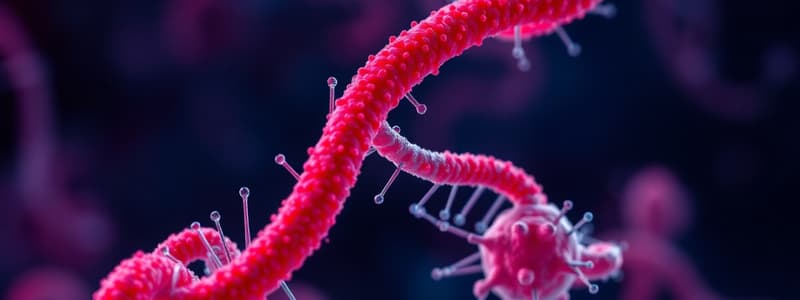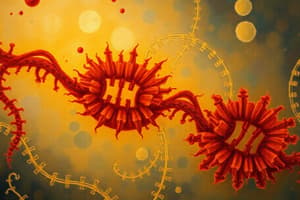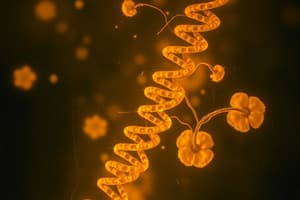Podcast
Questions and Answers
What does the TrpR regulon primarily include?
What does the TrpR regulon primarily include?
- All genes in the trp operon including trpR itself (correct)
- Genes that respond to nutrient availability
- Only genes involved in zinc homeostasis
- Genes responsible for responding to DNA damage
What is catabolite repression primarily concerned with?
What is catabolite repression primarily concerned with?
- Ensuring cells preferentially use the most effective energy source (correct)
- Inducing SOS genes after DNA damage
- Increasing energy expenditure for toxic substances
- Regulating the synthesis of structural proteins
What is the main role of DnaK during heat shock conditions?
What is the main role of DnaK during heat shock conditions?
- To break down denatured proteins
- To bind to new proteins and help them fold
- To bind to denatured proteins and help them refold (correct)
- To assist in cellular respiration
Which statement accurately describes global regulons in bacteria?
Which statement accurately describes global regulons in bacteria?
What characterizes a two-component signal transduction system (STS) in bacteria?
What characterizes a two-component signal transduction system (STS) in bacteria?
What characterizes negative regulation in gene expression?
What characterizes negative regulation in gene expression?
What is the role of an inducer in gene expression regulation?
What is the role of an inducer in gene expression regulation?
Which type of regulation ensures genes are only expressed when necessary?
Which type of regulation ensures genes are only expressed when necessary?
What is the function of riboswitches in mRNA?
What is the function of riboswitches in mRNA?
What do co-repressors do in gene regulation?
What do co-repressors do in gene regulation?
Which levels can gene expression regulation occur at?
Which levels can gene expression regulation occur at?
What triggers the conformational change in a riboswitch?
What triggers the conformational change in a riboswitch?
What does a positive regulatory system primarily depend on?
What does a positive regulatory system primarily depend on?
What effect does tRNA without an attached amino acid have on gene expression?
What effect does tRNA without an attached amino acid have on gene expression?
What is the role of small molecules in relation to metabolite-binding riboswitches?
What is the role of small molecules in relation to metabolite-binding riboswitches?
How does RNase E concentration affect mRNA degradation?
How does RNase E concentration affect mRNA degradation?
What is the typical half-life of some mRNA transcripts?
What is the typical half-life of some mRNA transcripts?
What is a potential function of sRNAs in bacteria?
What is a potential function of sRNAs in bacteria?
Which molecule is NOT typically associated with metabolite-binding riboswitches?
Which molecule is NOT typically associated with metabolite-binding riboswitches?
What is a common modification required for proteins to become active?
What is a common modification required for proteins to become active?
How does increased mRNA half-life affect protein production?
How does increased mRNA half-life affect protein production?
What role do small RNAs (sRNAs) commonly play in translation regulation?
What role do small RNAs (sRNAs) commonly play in translation regulation?
What type of RNA are sRNAs classified as?
What type of RNA are sRNAs classified as?
In feedback inhibition, what does the end product of a metabolic pathway do?
In feedback inhibition, what does the end product of a metabolic pathway do?
What happens to gene expression when tRNA is bound to an attached amino acid?
What happens to gene expression when tRNA is bound to an attached amino acid?
Where can sRNAs be encoded?
Where can sRNAs be encoded?
What term describes several distinct operons controlled by a single regulatory protein?
What term describes several distinct operons controlled by a single regulatory protein?
Which of the following is NOT a likely reason for organisms to implement regulation mechanisms?
Which of the following is NOT a likely reason for organisms to implement regulation mechanisms?
Which process is used to modify polypeptides after translation to regulate activity?
Which process is used to modify polypeptides after translation to regulate activity?
What is the primary purpose of global regulatory mechanisms in bacteria?
What is the primary purpose of global regulatory mechanisms in bacteria?
How do proteins and sRNAs generally affect translation initiation?
How do proteins and sRNAs generally affect translation initiation?
Why might an mRNA molecule be produced if it is not immediately translated?
Why might an mRNA molecule be produced if it is not immediately translated?
What type of temperature response mechanism is mentioned in the content?
What type of temperature response mechanism is mentioned in the content?
Flashcards
TrpR regulon
TrpR regulon
A group of genes, including the trp operon genes and trpR itself, regulated by the TrpR protein.
LexA regulon
LexA regulon
A group of genes, called SOS genes, activated in response to DNA damage.
Catabolite repression
Catabolite repression
A mechanism where a cell prioritizes using the most readily available energy source (like glucose) over other energy sources.
Two-component signal transduction system
Two-component signal transduction system
Signup and view all the flashcards
Heat shock response
Heat shock response
Signup and view all the flashcards
Negative Regulation
Negative Regulation
Signup and view all the flashcards
Positive Regulation
Positive Regulation
Signup and view all the flashcards
Inducible System
Inducible System
Signup and view all the flashcards
Repressible System
Repressible System
Signup and view all the flashcards
Riboswitch
Riboswitch
Signup and view all the flashcards
Transcriptional Regulation
Transcriptional Regulation
Signup and view all the flashcards
T Box Mechanism
T Box Mechanism
Signup and view all the flashcards
Gene Expression Levels
Gene Expression Levels
Signup and view all the flashcards
sRNA regulation of translation
sRNA regulation of translation
Signup and view all the flashcards
Translation initiation
Translation initiation
Signup and view all the flashcards
Translation elongation
Translation elongation
Signup and view all the flashcards
Post-translational modification
Post-translational modification
Signup and view all the flashcards
Phosphorylation
Phosphorylation
Signup and view all the flashcards
Feedback inhibition
Feedback inhibition
Signup and view all the flashcards
Regulon
Regulon
Signup and view all the flashcards
Global regulation
Global regulation
Signup and view all the flashcards
Regulatory proteins
Regulatory proteins
Signup and view all the flashcards
Environmental changes
Environmental changes
Signup and view all the flashcards
tRNA Without Amino Acid
tRNA Without Amino Acid
Signup and view all the flashcards
tRNA With Amino Acid
tRNA With Amino Acid
Signup and view all the flashcards
Transcription Attenuation
Transcription Attenuation
Signup and view all the flashcards
mRNA Half-Life
mRNA Half-Life
Signup and view all the flashcards
Increased Half-Life
Increased Half-Life
Signup and view all the flashcards
RNase E
RNase E
Signup and view all the flashcards
sRNA
sRNA
Signup and view all the flashcards
sRNA Regulation
sRNA Regulation
Signup and view all the flashcards
Intergenic Regions
Intergenic Regions
Signup and view all the flashcards
Study Notes
Advanced Microbiology: Lecture 13 - Regulation of Gene Expression: Genes & Operons
- Gene expression is regulated to allow cells to express only necessary genes in specific environments.
- Regulation occurs at various levels: transcriptional, posttranscriptional, translational, and posttranslational.
- Negative regulation: genes are constitutively expressed unless a repressor protein turns them off.
- Positive regulation: genes are not expressed unless an activator protein turns them on.
- Regulation can be inducible or repressible, or both.
- Inducers increase gene expression by activating an activator or inactivating a repressor.
- Co-repressors decrease gene expression by activating a repressor or inactivating an activator.
- Apo- vs. holo-proteins: Apoproteins are inactive forms, while holoproteins are active forms.
Negative Regulation in the Lac Operon
- Negative inducible system: In the absence of lactose, the repressor protein (LacI) binds to the operator, preventing RNA polymerase from transcribing the lac genes.
- In the presence of lactose (as allolactose), allolactose binds to the repressor, causing a conformational change that prevents the repressor from binding to the operator, allowing transcription.
Negative Regulation in the Trp Operon
- Negative repressible system: In the absence of tryptophan, the repressor protein (TrpR) is inactive, allowing transcription of the trp genes.
- In the presence of tryptophan, tryptophan binds to the repressor protein, activating it. The activated repressor then binds to the operator, blocking transcription.
Positive Regulation
- Positive inducible system (e.g., arabinose operon): Presence of arabinose activates arabinose-activating protein, which then binds to the promoter region, increasing transcription.
Riboswitches
- RNA elements in mRNA leaders that sense metabolites.
- 3D structures of RNA bind to metabolites.
- Binding of metabolites leads to conformational changes.
- These changes affect terminator/anti-terminator alteration and access to ribosomal binding sites.
- Can affect the expression of genes.
tRNA Sensing
- This mechanism is responsible for gene expression of aminoacyl-tRNA synthetases.
- Amino acid attachment to tRNA affects expression; without attached amino acids, expression increases, and with attached amino acids, expression decreases.
- Unpaired regions of leader RNA in the absence of the appropriate amino acid allow for antiterminator formation.
- Expression decreased with tRNA with attached amino acids due to terminator formation.
Metabolite-binding Riboswitches
- Small molecules bind directly to leader RNA.
- They are involved in same metabolic pathway.
- Many types of molecules (atoms) bind: amino acids, vitamins, nucleic acid bases, cofactors, and metal ions.
- Binding can lead to transcription attenuation or blocking.
mRNA Degradation Regulation
- Half-life — the time it takes a template to reduce to 50% of the original amount.
- Some transcripts last only minutes.
- Increased half-life correlates to increased protein production.
- RNase E targets its own mRNA.
- Low RNase E leads to increased message, while high RNase E leads to mRNA degradation.
Regulation by sRNAs
- Small RNAs (sRNAs) are non-protein-coding RNAs involved in posttranscriptional regulation.
- sRNAs encoded in intergenic regions or antisense can form secondary stem loop structures.
- May play a role in physiological regulation, metabolism, and virulence.
Mechanisms of sRNA Interactions
- sRNAs can inhibit translation by blocking ribosomal binding sites (RBS).
- sRNAs can destablize target RNA by recruiting RNase.
- sRNAs enhance translation by exposing occluded RBSs.
- sRNAs stabilize target RNA by preventing RNase cleavage.
Regulation of Translation
- Translation initiation is mRNA structure-sensitive.
- Elongation is less sensitive to mRNA structure.
- Proteins and sRNAs can block translation initiation regions preventing 30s binding.
- Proteins/sRNAs can also disrupt secondary structure of mRNA exposing RBSs, activating translation.
- Specific examples include the thermosensor RNA thermometer and how factors like temperature affect translation.
Posttranslational Regulation
- Not all polypeptides are immediately active proteins; some require modification.
- Common modifications include phosphorylation, methylation, and acetylation.
- Phosphorylation serves as a common signal in transducer signals and two-component systems.
Feedback Inhibition
- Products of a pathway bind to the first enzyme in the pathway preventing further reaction.
- This is a common mechanism in biosynthetic pathways.
- It is a fast and sensitive mechanism for modulating the amount of end product.
- Trp operon is a great example.
Global Regulation: Regulons & Stimulons
- Bacteria must adapt quickly to environmental changes in nutrients, moisture, and temperature.
- Global regulatory mechanisms enable simultaneous regulation of numerous operons.
- Regulons: clusters of genes controlled by a single regulatory protein. (TrpR regulon, LexA regulon, and AdcR regulon).
- Stimulons: collections of associated regulons that respond to the same environmental conditions.
Catabolite-sensitive Operons
- Catabolites are smaller molecules produced from larger molecule degradation.
- Energy for catabolism of different carbon sources often requires different enzymes.
- Catabolite repression ensures cells prefer the best energy source.
- Examples include the repressions occurring in glucose or galactose use, and how these preferences affect gene expression.
Stress Responses in Bacteria
- Bacteria have global regulons responding to numerous stress conditions like osmolarity, pH, temperature, metal availability, and nutrient access.
- These responses may influence each other.
- The Heat Shock Response is an example, where heat shock proteins increase after temperature increases.
Signal Transduction Systems (STS) in Bacteria
- Some gene regulation involves sensing external environment.
- Two-component systems are often used for environmental sensing:
- Histidine kinase sits in the membrane, senses the environment, and autophosphorylates.
- Response regulator accepts phosphate from the histidine kinase and regulates gene expression.
Studying That Suits You
Use AI to generate personalized quizzes and flashcards to suit your learning preferences.




